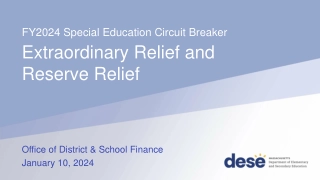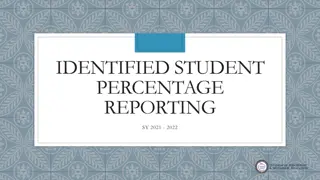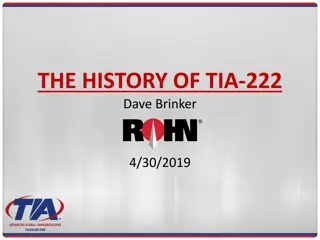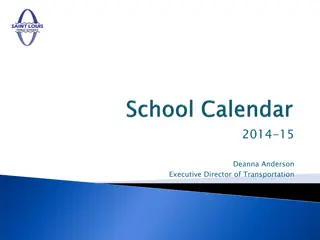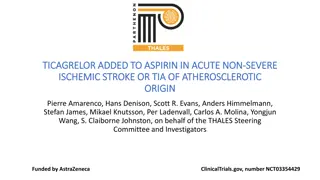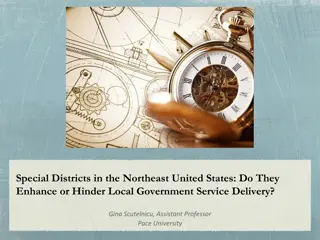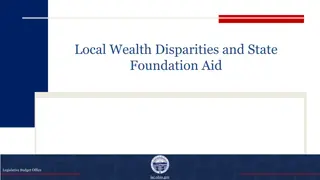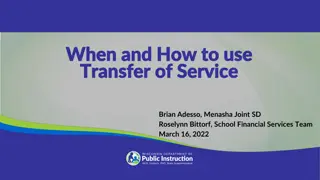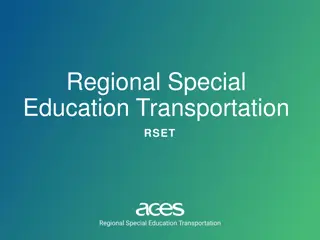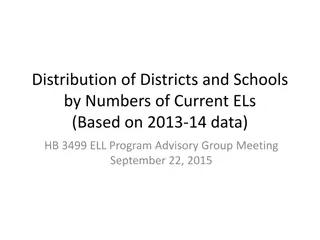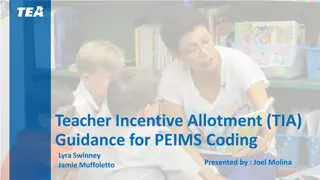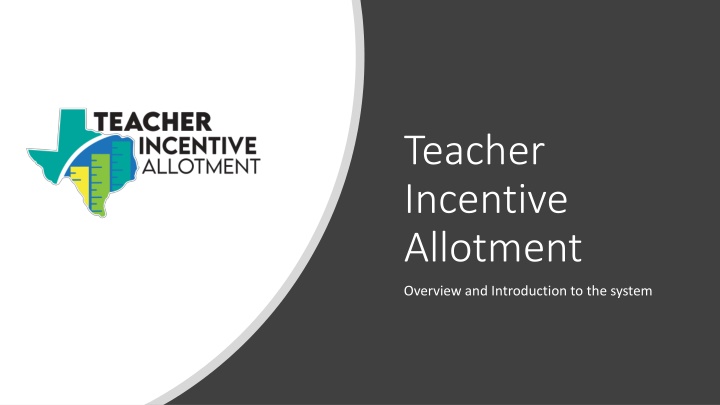
Teacher Incentive Allotment System in Texas
The Teacher Incentive Allotment (TIA) in Texas provides a pathway for teachers to increase their income while remaining in the classroom, recognizing effective teachers at different levels and offering additional funding to districts. Learn about the teacher designations, how teachers can become designated, and the requirements for the local designation system approval.
Download Presentation

Please find below an Image/Link to download the presentation.
The content on the website is provided AS IS for your information and personal use only. It may not be sold, licensed, or shared on other websites without obtaining consent from the author. If you encounter any issues during the download, it is possible that the publisher has removed the file from their server.
You are allowed to download the files provided on this website for personal or commercial use, subject to the condition that they are used lawfully. All files are the property of their respective owners.
The content on the website is provided AS IS for your information and personal use only. It may not be sold, licensed, or shared on other websites without obtaining consent from the author.
E N D
Presentation Transcript
Teacher Incentive Allotment Overview and Introduction to the system
The Teacher Incentive Allotment (TIA) gives teachers an accessible pathway to earning a higher income while remaining in the classroom, allowing them to make a greater difference in the lives of Texas students. Teachers do not apply for TIA. Unlike previous education programs, the Teacher Incentive Allotments are additional state funding written into statute allowing for sustainable funding. There are no caps on teacher designations or allotment funds. Texas Teachers and TIA
What Is the Teacher Incentive Allotment? HB 3 established the Teacher Incentive Allotment (TIA) to recognize effective teachers on three different levels: Recognized, Exemplary and Master. These teacher designations generate additional teacher-focused allotment funding for districts in order for them to reward their top performers.
What are Teacher Designations? Designations are distinctions awarded to highly effective teachers. TIA established three levels of designation: Recognized, Exemplary, and Master. Designations are awarded to teachers either through their district s local designation system or by achieving National Board Certification. A local designation system can designate teachers at any level. Teachers with an active National Board certification may be designated as Recognized be the Texas Education Agency (TEA). Once a teacher is designated, they may generate an annual allotment for their employing school district based on their campus of employment.
Becoming a Designated Teacher Districts have the option to build a local designation system to designate teachers as Recognized, Exemplary, or Master. Before applying for a local designation system, districts develop evaluation criteria based on teacher observation and student growth data to identify their most effective teachers. A local designation system must be approved by TEA before the district can issue designations. This requires a two-step application and approval process.
Local Designation System Requirements At minimum, the designation system must include both a teacher observation and a student performance component: The systems must be submitted to TEA for approval and undergo a data-validation process, which will be conducted by Texas Tech University. As part of the validation process, Texas Tech will: Teacher observation based on T-TESS; a third-party rubric, such as the NIET TAP, Marzano, or Danielson rubric. District application must show evidence of validity and reliability. Review alignment between teacher observation ratings and student performance ratings. Student growth measures determined by district. Can include pre- and post-tests, value-added measures, student learning objectives (SLOs), and portfolios. District application must show evidence of validity and reliability. Review alignment between student performance ratings and value-added ratings for applicable teachers. Review data validity by appraiser/rater, by campus, across campuses in a district, and by teaching assignment. Districts can use other factors in determining the teachers eligible to receive a designation, such as student surveys, teacher leadership responsibilities, teacher mentorship responsibilities, family surveys, demonstration of district core values, teacher peer surveys, and contributions to the broader school community. Compare district data to state data by comparing the percentage of teachers a district puts forth for designation to overall district performance.
District System Components Teacher Observation Observation based on T-TESS or aligned rubric . District application must show evidence of calibration and data analysis. Student Growth Student growth measures determined by district. District application must show evidence of validity & reliability of development, administration, and scoring. Districts must spend at least 90% on teacher compensation for student-facing instructional roles and may reserve up to 10% for supporting the TIA system or in supporting teachers in earning a designation by 8/31 each year. Spending Plan Optional Components Districts may consider additional factors in make designations (e.g., mentoring other teachers, teacher leadership, family surveys, student surveys, etc.).
Cohort F System and Approval Timeline Pre-Application 2021-2022 Year 1 2022-2023 Year 2 2023-2024 Year 3 2024-2025 Post-Approval 2025-2030 System Development System Application Capture Data Data Submission New or Higher Designations Full System Approval Stakeholder Engagement TIA Teacher Buy-In Survey Expansion and Modifications Designate & Compensate Annual Program Submission Expansion & Modifications TIA Annual Evaluation Surveys TIA Annual Evaluation Surveys Annual Program Submission
National Board Certification Individual teacher achieves National Board Certification Districts may choose to support cohorts of National Board candidates OR How Designations are Earned Local Optional Teacher Designation System District-created system District system is approved District determines and issues teacher designations
Who Can Earn a Designation? How Will We Designate? Observations, student growth measures and any optional components Performance standards and weighting for all components Eligible campuses and eligible teaching assignments If not all teachers, will we expand in future years? The Big Three Critical Decisions How and When Will We Compensate? Distribution of funds Timing and mode of compensation
Teacher Incentive Allotment For more information about TIA, please visit https://tiatexas.org/
Sanford-Fritch ISD Planning Sanford-Fritch ISD has submitted a LOI as a Cohort F District. Sanford-Fritch ISD will begin system development stakeholder engagement strategies in the coming weeks
District Information TIA committee members (TBD)
District Information Teacher Observation / Student Growth Committees (TBD)
District Information Spending Plan Committee (TBD)
For questions contact: Kim Surles 806/397-0621 or ksurles@sfisd.net

